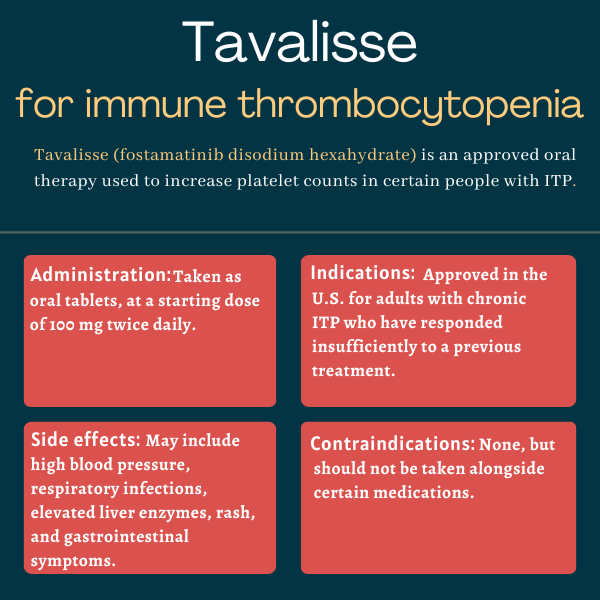
Tavalisse (fostamatinib disodium hexahydrate) for immune thrombocytopenia
Last updated July 14, 2025, by Lindsey Shapiro, PhD

What is Tavalisse for immune thrombocytopenia?
Tavalisse (fostamatinib disodium hexahydrate) is an approved oral medication used to treat thrombocytopenia, or low platelet levels, in adults with chronic immune thrombocytopenia (ITP) who have had an insufficient response to a previous treatment.
Taken twice daily in the form of oral tablets, it is expected to increase platelet levels and reduce the risk of bleeding events.
In ITP, the immune system mistakenly attacks and destroys platelets, which are cell fragments needed for proper blood clotting. Tavalisse blocks an enzyme called spleen tyrosine kinase that’s important for the chain of events that cause immune cells to destroy platelets. This should help to protect platelets against destruction and lower the risk of significant bleeding.
Tavalisse was developed and is marketed in the U.S. by Rigel Pharmaceuticals, with other companies holding commercialization rights elsewhere.
Therapy snapshot
| Brand name: | Tavalisse |
| Chemical name: | Fostamatinib disodium hexahydrate |
| Usage: | Used to increase platelet levels and lower the risk of bleeds in certain adults with ITP. |
| Administration: | Oral tablets |
Who can take Tavalisse?
Tavalisse is approved in the U.S. for the treatment of thrombocytopenia in adults with chronic ITP who have had an insufficient response to a previous treatment.
While its prescribing information lists no contraindications, Tavalisse is generally not recommended for use alongside certain medications that strongly interfere with the activity of CYP3A4, the enzyme that breaks down Tavalisse’s active ingredient.
Tavalisse is similarly approved in other countries, including in the European Union, where it is sold as Tavlesse.
How is Tavalisse administered?
Tavalisse comes in oral tablets that are swallowed whole with or without food. The initial starting dose is 100 mg, taken twice daily. This may be increased later to achieve the desired platelet level to reduce bleeding risk.
A dose reduction may be needed to manage side effects, but if that means receiving a dose that’s less than 100 mg per day, the therapy should be discontinued. Stopping treatment is also recommended if platelets levels don’t reach the desired level after three months.

Tavalisse in clinical trials
Tavalisse’s approval was mainly supported by two identical Phase 3 clinical trials — FIT-1 (NCT02076399) and FIT-2 (NCT02076412) — as well as FIT-3 (NCT02077192), their open-label extension study.
The Phase 3 studies involved a total of 150 adults with chronic or persistent ITP who had an insufficient response to previous treatments, including corticosteroids, immunoglobulins, splenectomy (spleen removal surgery), and/or thrombopoietin receptor agonists. Treatment lasted 24 weeks, or about six months.
- Combined data from FIT-1 and FIT-2 showed significantly more people on Tavalisse than a placebo achieved a stable treatment response, which was defined as achieving a platelet count sufficient enough to lower bleeding risk for at least four of the last six study visits. The use of rescue medications and bleeding events were also less frequent with Tavalisse.
- The FIT-3 then enrolled 123 patients, including those who completed the 24 weeks of treatment in the Phase 3 trials or who failed to respond to treatment after 12 weeks. Results demonstrated the therapy’s long-term safety and efficacy, with many patients maintaining a durable platelet response.
Common side effects of Tavalisse
The most common side effects of Tavalisse include:
- diarrhea
- high blood pressure
- nausea
- respiratory infection
- dizziness
- elevated levels of liver enzymes
- rash
- abdominal pain
- fatigue
- chest pain
- low blood levels of neutrophils, a type of immune cell, which can increase infection risk.
People on Tavalisse will be monitored for certain side effects that could become serious. This includes:
- blood pressure changes
- severe diarrhea
- low neutrophil counts and infections
- altered liver enzymes, suggesting liver toxicity.
In some cases where these side effects are severe, Tavalisse may need to be paused or discontinued, or the dose reduced.
Based on findings from animal studies and its known mechanism of action, Tavalisse may cause fetal harm if taken by a pregnant woman. Women who can get pregnant should obtain a negative pregnancy test before starting Tavalisse, and use effective contraception during treatment and for at least one month after the last dose. They should also not breastfeed during that period.
Bleeding Disorders News is strictly a news and information website about the disease. It does not provide medical advice, diagnosis, or treatment. This content is not intended to be a substitute for professional medical advice, diagnosis, or treatment. Always seek the advice of your physician or other qualified health provider with any questions you may have regarding a medical condition. Never disregard professional medical advice or delay in seeking it because of something you have read on this website.
Recent Posts
- ITP treatment Doptelet may help prevent bone loss in osteoporosis
- Bleeding risk high soon after kidney transplant in VWD, hemophilia A
- Combined therapy aids recovery for woman with TTP and lupus
- An ITP diagnosis wasn’t the final word on my health setbacks
- Cell therapy QT-019B shows strong response rate in hard-to-treat ITP
Related articles
-

-
-

THROMBOTIC THROMBOCYTOPENIC PURPURA
NewsCombined therapy aids recovery for woman with TTP and lupus
-
-
-




